On the participation of animals in hostilities
* The bats became participants of the Second World War due to an American dental surgeon who, after the Japanese attacked the US Navy base at Pearl Harbor, suggested attaching tiny bombs to the bats, but not according to the action of the bomb. Mice, as a rule, are arranged under the roofs of houses - here and numerous explosions, albeit small, in Japanese cities. The idea was approved by Roosevelt, preliminary, considered successful experiments were conducted on six thousand mice (they managed to set fire to an imitation of a Japanese village), for which the US Navy spent about two million dollars. However, the matter did not go further. There are several reasons for this. The idea itself looked like this: on the body of the mouse reinforced a small time bomb. The animals were placed in special containers in which a constant low temperature (about four degrees of heat) was maintained — this was necessary for the mice to remain in a state of hibernation. Further they were planned to be dropped from a height on Japanese settlements. In flight, the containers were opened, and the bats were supposed to find secluded places in attics and roofs and, in fact, explode. However, in fact, the bats either crashed (not everyone was able to fly with a load), or went back and set fire to their own objects.
* Elephants the first "hired" for military service were Hindus (although in one school textbook stories I came across the opinion that Alexander the Great was the first to guess to use them). Huge animals acted as living tanks and were so successful that this practice soon spread to the Middle East. Here, as they say, the soldiers killed several birds with one stone at once: firstly, the elephant is very hardy and strong, it can carry a load of more than half a ton on its back for a long time; secondly, the horses of the enemy were frightened of the elephants, and thereby confusion was created in the camp of the enemy; thirdly, the opponents themselves were shocked by the terrible sight. True, the use of elephants was not very simple: these animals are quite peaceful, and loud sounds and bustle brought them to a very excited state. And falling into a panic, the elephant becomes uncontrollable and can even trample its own.
* Mules proved to be much more enduring than their mother horses, and much smarter than their donkey fathers. Rights, mules are very stubborn, which prevented them from becoming full-fledged "fighters." As a result, they were obliged to deliver food and weapons. Thus, in the army of the ancient Roman legionaries for every ten people there was one porter-mule. Napoleon Bonaparte also used these animals extensively in his army, and even rode a mule through the Alps.
*Role horses in hostilities it is difficult to downplay. Here are some figures of the history of the 20 century: during the Great Patriotic War, there were about two million horses in our army (of which about a million were lost). Horses were used not only as "fighters", but also as a transport force. Animals were brought to the position of carts with food, field kitchens. By the way, it was for these purposes that each rifle regiment was supposed to have three hundred and fifty horses. In addition, the Sivk-Burkas were dragging their guns behind them — six horses could pull the gun. And if we are talking about the famous Vladimir heavy trucks, they dragged and huge howitzers. Here is such a stroke. If our soldiers “enrolled” captured German horses into their ranks, then, as a rule, they did not count on their stamina. Our horses were much more hardened, they could work for many days, eating only straw from the roofs.
It must be said that at the beginning of the war the number of horses in the German army was not very large - the fascists clearly underestimated the advantages of horses. However, in the first year of the war, having understood the benefits of horses, the Germans tried to rectify the situation - at the expense of our occupied territories.
The horses were greatly helped by the partisans. In addition, for this animal there is no concept of "off road" - the horse can go everywhere, and unnoticed, unlike the car. And an example of the famous corps of General Lev Mikhailovich Dovator, who during the battle for Moscow bound the rear of an entire army! “We are constantly confronted with equestrian units,” wrote General Halder, chief of the General Staff of the Wehrmacht. - They are so maneuverable that it is not possible to use the power of German technology against them. The realization that not a single commander can be calm for his rear forces has a depressing effect on the morale of our troops ... ”
It should be noted and the work of the Soviet veterinary service. Soldiers never abandoned wounded horses, but collected them after each battle and were taken to veterinary hospitals, even by special vehicles. Here, wounded horses were operated, treated and returned to service.
* Use as a marine scout and miner sealshaving amazing localization abilities, the first in 1916 was proposed by the famous trainer Vladimir Leonidovich Durov. For a long time he was engaged in training of seals and sea lions and came to the conclusion that these animals are quite capable of incapacitating enemy ships, cutting mines at dead anchors and even rescuing drowning people. Interestingly, almost simultaneously with an outstanding trainer, similar experiments were conducted by the American physicist Robert Wood (he taught seals to react to the sound of the screws of a submarine). Very strange: at the same time, the inexplicable death of Durov's experimental seals happened: according to the autopsy, they were all poisoned ...
Vladimir Leonidovich repeatedly addressed the commander of the Black Sea fleet, wrote to the Ministry of the Sea. His proposal was accepted with surprise and promised to contribute. However, nothing came of this.
But there is evidence that in the 1942, seals were used as miners of the Swedish Navy - thus destroying German submarines.
* Enlist in the soldiers seagulls British prompted the behavior of birds. The fact is that when seagulls catch sight of a ship, they are able to accompany it for quite a long time, hoping to profit from kitchen waste, because they are thrown overboard. Noticing this feature, the British Admiralty ordered all patrol vessels and submarines to often throw large amounts of food into the sea, mainly bread. As a result, birds were accustomed to gather in flocks above the courts - a sort of live radar that helped detect enemies.
* Although this case is considered by many to be a legend, however, it is described in some history textbooks. In the 15 century, the ruler of Albania, George Kastrioti, resisted the entire 25 years for invading the territory of his country of the Ottoman Empire. One day he went to this trick: thousands goats tied a candle to the horns. And at night, in the dark, when the enemy saw an incredible amount of moving lights, he decided that it was a huge crowd of people and turned back. True, there remains a doubt: did the attackers not hear the goat "mekanya"? It is unlikely that the animals were silent ...
* firefliesPerhaps the most unusual and peaceful participants in hostilities. During the First World War, the British planted insects in cans and thus “carried out the lighting”, read and wrote letters, and worked with maps without any special interferences.
* About the role cats in the war we will not speak in detail. In the "Military Review" I have already published material about what assistance was provided by specially brought baleen fighters to besieged Leningrad, helping people fight rats. There were many cases when the meows served as live radars, because they feel the approach of the bombers for a long time, because many fighters specially kept cats at home. By the way, for the cats who saved human lives in this way, a special medal was established during the war - “We also serve the Motherland”.
* Dogs. You can talk about them very, very much, but I also wrote about this, the site has the text “Balls and bobbies on the war fronts”. In it are a few examples of real feats of dogs: the Airedale Terrier Kashtanka, who worked as a liaison officer, and for several days in the battles of Naro-Fominsk kept our division in touch with the reserve. Sanitary Bobike, who saved many human lives, including his master Dmitry Torokhov. Dike Mine Detector, who discovered 11 thousands of mines. About one hundred and fifty shepherds, which in August 1941, during the onset of enemies in Kiev, fought near the village of Legezdino. About signaling dogs who, during the war years, laid 8 thousands of kilometers of telephone wire. About the faithful Djulbarse, who participated in the first Victory Parade ...
* Oh, that's about the role pigeons in the war there was no large, complete material in the Military Review, I will definitely write it. And in today's text - a little, but important.
The first military pigeon stations were introduced by their order in 1884 year, Minister PS Vanovsky. A pioneer in the use of pigeon mail during hostilities was an officer of the Turkestan Military District, Lieutenant Grigory Lalekin, who organized a “winged” mail at his unit. Over time, the pigeons learned to deliver messages from Tashkent to military units and headquarters, but the birds became especially useful during maneuvers: soldiers sent reports with them.
In the Russo-Japanese War, pigeons helped control the army — they delivered orders. A special military pigeon station was even formed in Port Arthur, where they contained about fifty birds.
During World War II, the Ostankino nursery of the USSR Academy of Sciences became the main supplier of young birds for the front. The role of the birds was so great that the German command gave the order to shoot the pigeons in flight. Dove helped our fighters where the technician refused to work. Birds delivered messages from the front line, called for reinforcements. The case of the pigeon with the number 48, which saved a squad of scouts from destruction, is known. The winged signalman could even get away from the hawk trained by the Germans and chased him to the station wounded, with a broken foot - he was then treated for a long time by veterinarians.
Only within a month of the offensive of our troops in the Baltic States, the winged postal service delivered combat messages from the front lines of 2659 — about ninety letters a day!
Many of you, of course, remember the famous song: “Vitya Cherevichkin Lived in Rostov” - about a teenager whom the Germans executed for refusing to destroy their mail sisaris and released them before the fascists. In his hometown, a monument to the brave boy with a pigeon in his hands, and his case appeared in the Nuremberg trials.
During the war years, the birds delivered 15 thousands of blue pounds! And how many lives because of this were saved ...
* To help our troops during the Battle of Stalingrad in Astrakhan, the 28-I reserve army was formed, equipped with guns. But here the question arose: how to move the technique? No cars, too few horses. And then the call was thrown to the local population: need camels! They were delivered to about three hundred and fifty, but the soldiers had to tinker before they taught the animals to new work for them. Yes, and the fighters themselves needed to learn how to manage "live transport". Local shepherd boys came to the rescue. They helped teach camels to harness. Things went smoothly. Moreover, the camel is stronger than a horse. And if it takes six horses to transport a cannon, then there are only four camels.
After encircling the fascists in Stalingrad, the reserve army received orders to move toward Rostov. But here she came across Manstein's tank grouping, which was retreating in the same direction. The defense was held by the 771 artillery regiment. During the battle, a very large part of the camels died, because huge animals could not hide in the trenches. And some of the animals got together in the fighters to Rostov, where the reserve army was equipped with equipment. Now the camels were no longer needed, but the soldiers were in no hurry to part with them. Animals began to pull the camp kitchens, ammunition carts - they were no longer afraid of explosions and were accustomed to fighting life. During the raids at the command of their sleds, they raced into the nearest thicket, lay down on the ground and even closed their eyes. The camel Tamara, who was dragging the camp kitchen, became especially famous: she could blow a trumpet, summoning fighters for lunch and dinner.
Two animals - Misha and Masha - during one of the battles in the open area could not hide. And then our soldiers under continuous fire reached the camels and took them to the ruins of a house to hide in the basement. True, the camels were too big, and the soldiers had to significantly expand the entrance. The animals remained alive and reached Berlin itself - now, near Astrakhan, there is a monument in their honor. The camel Yashka reached the capital of Germany. At first, medals taken from German officers were attached to him as awards. But then they decided that it was not suitable for a heroic animal to wear fascist insignia. And reinforced on the back poster "Astrakhan-Berlin."
After the war, all the surviving camels began to live in the Moscow zoo.
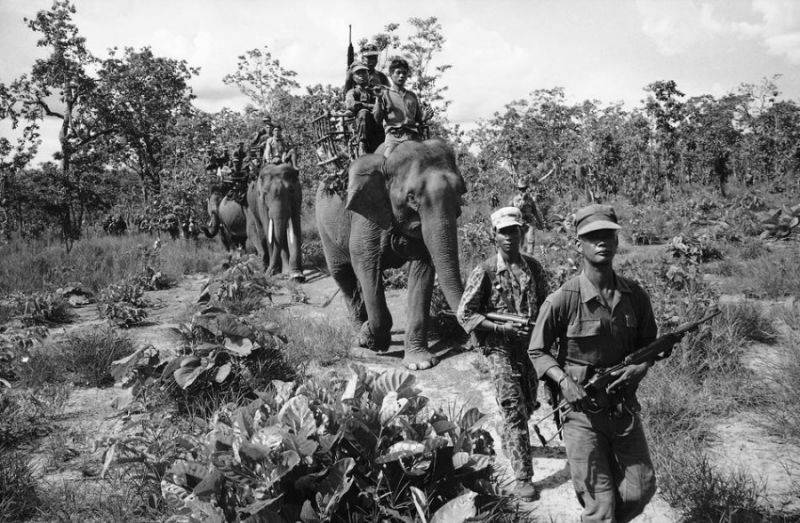
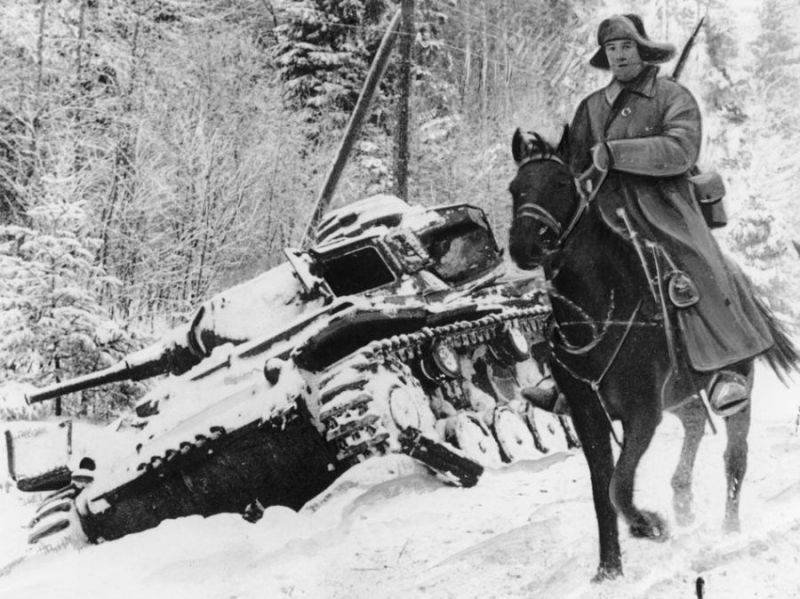
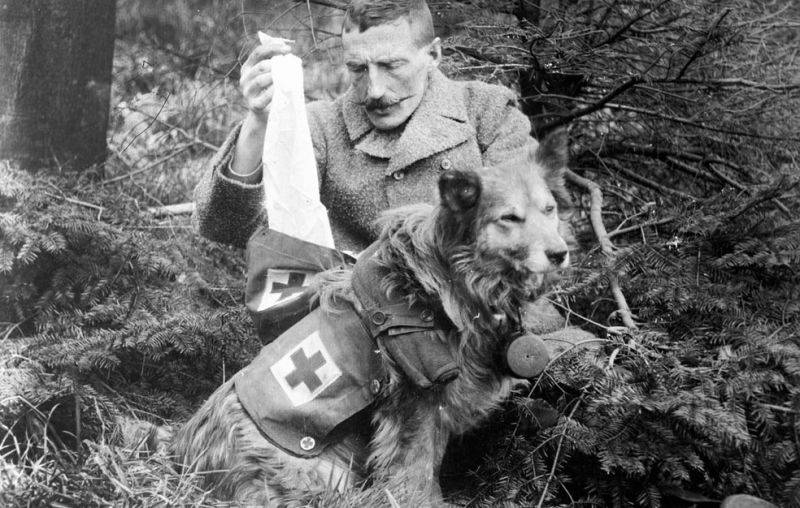
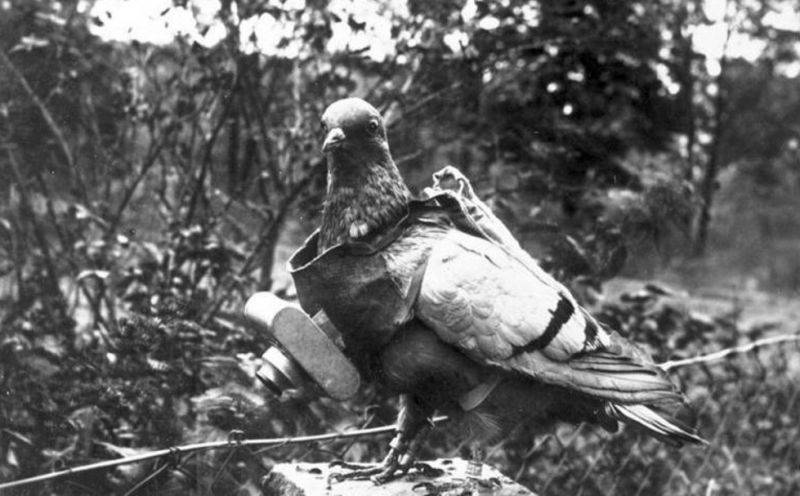
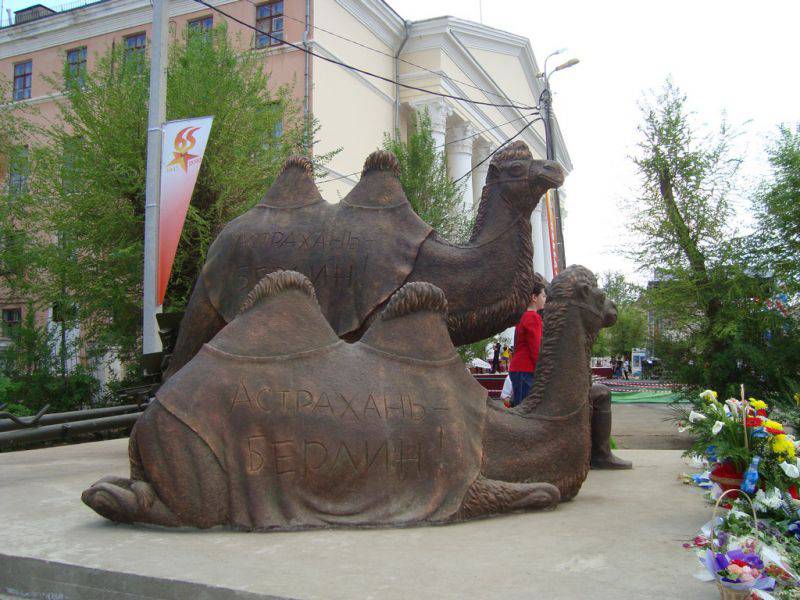
Information